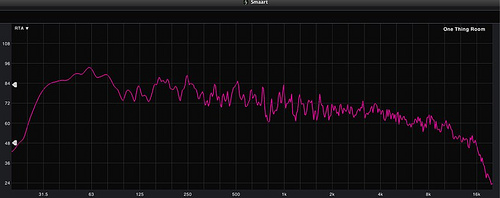
Slope Analysis Follwup
Steve asked a great question in the comments on my Slope Analysis post:
So do you tune your system to help provide the downward sloped response?
My response was “I do and I don’t”, but a better response would probably be to say “not intentionally.”
This is a little simplistic, but hopefully this might help explain it. In general, most reputable loudspeaker manufacturers like to engineer their speakers’ responses to be relatively flat, and they often show this off in their marketing and spec sheets. The nice thing about the concept of a flat loudspeaker for mix engineers is that the speaker, in theory, shouldn’t influence the tonal balance of the mix. What we put into the speaker is what comes out so we hold all the strings behind the console.
That’s all fine and dandy if we’re putting a single box up, but when we start working with larger PA’s and putting speakers together, fun things happen. When we start arraying or clustering loudspeakers together, the typical performance goes something like this: the lower frequencies in the boxes add together, and as we go higher in frequency each box becomes more and more independent. The result is the low frequency response of our system rises. Now look at the screencap below:
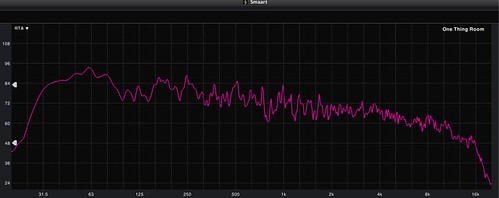
Measurement Mic at FOH
The screenshot above was a measurement captured while playing back tracks from rehearsal last week in the room. This is sort of our preferred frequency balance in the room these days.
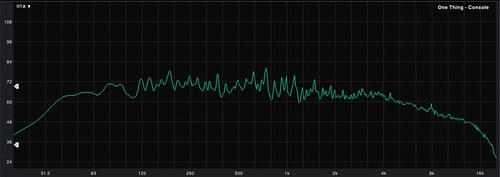
Direct Console Ouput
This next screenshot represents a measurement of the console’s output before it hits our system DSP. Notice how the low frequencies appear attenuated here relative to the room measurement? There is no EQ on the console side and nothing on the system boosting the low end response in the room. That boost in the room simply comes from letting the PA do what it naturally wants to do. In fact, there is actually array correction applied in our Meyer Galileos to compensate for the combined lower frequencies.
What’s happening on the PA side is made a little clearer in the transfer function of the PA below.

Loudspeaker System Transfer Function at FOH
**** Transfer Function 101 ****
A Transfer Function is basically a measure of two signals against each other. In this case we are measuring a microphone at FOH against the console output(our reference). If the sound in the room matched the console output, what we would see here is a flat line which would be referred to as a linear response; what goes into the system comes out the same or linearly. Dips represent things that are quieter in the room. Bumps represent things that are louder in the room.
**** End Transfer Function 101 ****
There’s more going on with this particular measurement than I really want to get into right now so I’m going to keep this pretty simple. I smoothed this a bunch to make this a little easier to read. What we can see here is the PA response is fairly linear above 500 Hz with a little bit of a bump in the 8-10k area. Below 500 Hz we can see that the response of the PA gently rises into a mountain of sub-band.
Now look back at the RTA measurement of the Direct Console Output above. The exaggerated low end PA response encourages a mix engineer to minimize excessive increases in the low frequencies on his console. This results in a flatter frequency response through the console and at its output which is a good thing and something I want.
The flatter response maintains headroom in the console. I want the warmth in the room, but our console’s mix buss doesn’t care about the frequency balance of the mix. If my PA was completely linear, I would probably be doing massive EQ surgery to emphasize the low end on my kick and bass on top of driving their inputs hard. But that kind of surgery can cause problems down the road especially in terms of console headroom. I don’t want kick and bass driving my output busses way up in order to get things to feel right in the room.
Plus, if I want to do any kind of buss compression on the mix or even just a parallel compressed drum group, the exaggerated frequency content would overly influence any compressors performance. Here’s a good example of what I mean by this: just think about all those camera phone concert videos on YouTube where the song starts out nice and pretty and then the first kick drum hits and slams the entire mix volume down. That’s not something I want happening with my compressors.
And then of course there’s the whole translation issue. A flatter response on the console output translates a lot better or is at least easier to make work outside the room. But, as I implied in the last post, sometimes the mix still needs a bit of help to translate so let’s look at this a little closer.
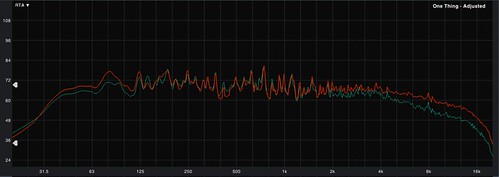
Console Output (Green/Blue) vs. Adjusted Output (red)
In the measurements above, the green trace represents the direct, unprocessed console output. The red represents my processed, CD mix that is used by the rest of our team to prep for Sunday. The red is also what feeds our hallways, video control room, and serves as the emergency feed for the webcast if our studio were to go down. It has a bit of EQ, some multi-band compression, a stereo widener, and a good ol’ Waves L2 on it.
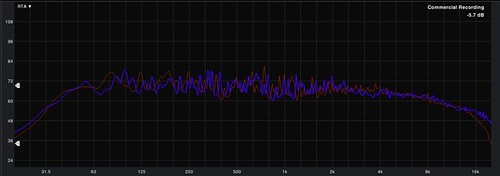
Commercial Recording (blue) vs. Adjusted Mix (red)
In this last screencap, I laid my commercial recording measurement over the adjusted/mastered mix, and you can see how much closer the frequency balance of my mix is compared to the commercial release. To make this happen, I applied my mastering processing while using Smaart’s RTA to get in the ballpark, and then I made some additional tweaks by ear. This is something I’m always tweaking a bit over time, but the goal is to keep the mastering processing pretty static so that I can make rehearsal mix evaluations at home, in the car, in my office, etc. That way when I get back behind the console, I can be more efficient with my time.
While screenshots are cool, sometimes hearing the difference makes things much clearer. The brief samples below were recorded at a recent event. The first sample is the dry, unaltered left/right mix that was feeding the PA, and the second sample is the mastering buss with a bit of the room mics thrown in. I always print both busses in case we ever have a mix we want to remaster. As you listen to these samples, I think the frequency balance differences will be pretty obvious.
[audio:slope-dry.mp3]
Dry Mix
[audio:slope-mastered.mp3]
Mastered Mix
In my opinion, the mastered version isn’t a true representation of what was happening in the room, however, I feel like it is much closer. At any rate, it sounds to me like a blanket has been pulled off the dry mix here. Of course, in the room at concert level I feel like I can skirt the edge of overly bright, and remember from above that the PA is bringing out even more low frequency and low-mid energy in that dry mix, and yet it works in that environment. This is just one more reason why I find the concept of equal-loudness so interesting.
Before I wrap this up, let me just reiterate something I said above in case you blew through it. Using an RTA is simply a way to get in the ballpark. It’s a reference. It is no substitute for listening. It doesn’t matter how it measures if it sounds good.





Very interesting bump in the sub. From what I’ve read the height depends on the room size but more specificly the rooms reverberation time. How large is your auditorium?
Am I correct in saying that this is the transfer function at the foh mixing location? How does the compare to say 10 other locations in that seating area? I only say that because I found in my experience that using only one location as opposed to several causes too much variations from the reading from day-to-day. Also, the results will show how well the foh mixing location sound is representative of the general auditorium sound.
I’d buy that about the sub bump. I tend to go by feel more with subs and not just by measurement. My room is about 2700 seats and the deck is at maybe 35′ or so.
That transfer function is at FOH. I have done many other measurements, and that is representative of the rest of the room. The bottom end cools off on the far sides where the sub coverage falls off, and you lose a bit of the low/low-mids at the back as you leave the Fresnel (near-field) region of the array and move into the Fraunhofer(Far-field) region. But it’s all within what I would consider an acceptable range.
I believe when a system has been properly designed and implemented, the FOH position will be representative of the room. When the FOH position is compromised, the mixer’s ability to evaluate and make decisions will always be compromised.
I routinely walk my room, but it’s to make sure that everything is still working the way it’s supposed to. I don’t need to walk it to figure out what works in different locations. If it works at my FOH, it will work outside of FOH.